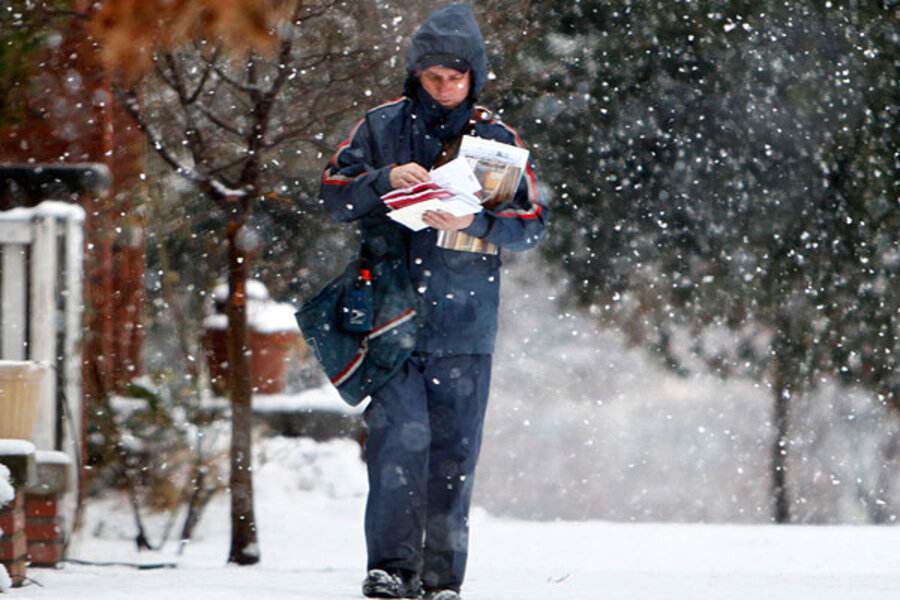Postal Service plans all-weather clothing line: Smart move or desperation?
Loading...
| New York
Well, we can’t say we saw this one coming.
The US Postal Service, known more for its stalwart reputation – and financial woes – than its vanguard fashion sense, announced Tuesday it is launching a fashion line as part of an effort to generate revenue and build brand reputation. The surprise move has retail analysts impressed – and doubtful.
The announcement certainly hasn’t left Gucci and Prada shaking in their stiletto-shearling boots. But considering the focus of the aptly named “Rain Heat & Snow” line – all-weather apparel – the venture starts to make sense. After all, who knows more about dressing for the elements than the Postal Service’s hale and hearty letter carriers, for whom “neither snow nor rain nor heat nor gloom of night” thwarts achievement of their solemnly sworn duty. (No word yet on whether the apparel will be pit bull-resistant.)
Fortunately, the Postal Service is sparing us the baby blue button-down shirts and navy pant-shorts. It is working with Ohio-based apparel company Wahconah Group Inc. to create a line of innovative “functional fashion” that should hit stores in 2014.
“This agreement will put the Postal Service on the cutting edge of functional fashion,” corporate licensing manager Steven Mills said in a statement Tuesday.
“We’re talking all-weather, all-seasonal attire,” says USPS spokesman Roy Betts. “A man’s jacket which could be wired for you to click in your iPod and listen to music, control the volume, and make selections, all from the sleeve of your jacket.”
In other words, the kind of hip athletic/tech/all-season apparel that might appeal to say, a computer-programmer-tech-enthusiast who enjoys listening to Linkin Park on his iPod while snowboarding with his buddies – in a Postal Service-emblazoned jacket, of course.
Besides jackets, the line will include headgear, footwear, and clothing that incorporates smart technology, says Mr. Betts.
“It’s incorporating technology that originated in the military ... and is now available commercially,” he says. “Being able to put wiring in fabric and other material that will allow you to monitor, respond, listen, and connect to your devices.”
(Interestingly, this isn’t the first time the Postal Service introduced a retail line. It rolled out a line of T-shirts, mugs, and neckties in the 1980s, which were sold in post offices until Congress complained that it was competing with private businesses.)
This time, perhaps recognizing its place in the natural order of things, the Postal Service is staying out of the actual designing of the clothing. Wahconah Group will design, manufacture, and place clothing in retail locations, including department and specialty stores, while the Postal Service will simply license its name, and hopefully, collect royalty fees.
The move, says Betts, is as much about re-envisioning the Postal Service’s brand as bringing in revenue.
“It’s brand reputation with revenue generation,” he says. “The Postal Service is facing challenges, and we are looking to be more innovative and responsive to the marketplace.”
In recent years the Postal Service has faced more than rough weather and choleric canines. The beleaguered agency reported losses nearing $16 billion last year and is scrambling to close a $20 billion budget gap in 2013. As part of that plan the Postal Service recently announced it will end Saturday mail delivery this summer, a move that will cut 22,000 jobs and save $2 billion.
The Rain Heat & Snow clothing line looks to be part of the agency’s effort to plug its yawning budget gap – and revamp its listing reputation – but retail analysts are divided on the venture’s potential for success.
“The Postal Service is not going to be successful with this whatsoever,” says Hitha Prabhakar, an author and retail analyst. “The USPS is not a sexy brand … and has been losing its brand gravitas for so long, I don’t know who would want to wear a US Postal Service shirt or pair of shorts.”
Retail expert Doug Fleener sees the clothing line as a relatively risk-free move for the Postal Service that dovetails with its image.
“What I thought was smart, what I like about it, is it’s all-weather gear,” says Mr. Fleener, president and managing partner of Dynamic Experiences Group, a retail and customer experience consulting firm in Lexington, Mass. “If I think about battling the elements, there’s probably no other company or organization that stands out more than the post office. To some degree, that’s kind of smart of them.”
“The Postal Service gets so much criticism. Their hands are tied and they don’t have a lot of options,” adds Fleener. “I give them credit – they found a way to drive risk-free revenue.”
Both Ms. Prabhakar and Fleener say the move is a form of brand extension not uncommon in the market for struggling labels.
“I think whenever you have a struggling brand – whether it’s the USPS or a designer that was once really luminary and has since lost its luster – I think brands [reinvent themselves] by starting alternate clothing lines,” says Prabhakar. “It’s brand extension in the form of clothes.”
As such, says Fleener, the Postal Service is “following the lead of a lot of brands out there that do licensing deals.”
Will the Postal Service’s latest venture reap rewards?
In fact, licensing has revived some companies, like Sharper Image, which went out of business and came back due to licensing deals, says Fleener.
Still, he doesn’t expect the agency’s new clothing line will rake in huge profits.
“It’s not going to generate a lot of revenue,” he says, “It will give them some nice publicity around an area of strength for the Postal Service.”
His advice for the agency as it tests the fickle waters of fashion? Stick to what it does best.
“Don’t try to overextend,” he says. “I’m not sure I want to wear Postal Service swim trunks.”







